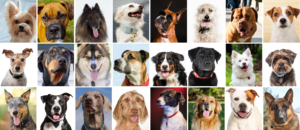Turcsán, B., Kubinyi, E., & Miklósi, Á. (2011). Trainability and boldness traits differ between dog breed clusters based on conventional breed categories and genetic relatedness. Applied Animal Behaviour Science, 132(1-2), 61-70. doi: https://doi.org/10.1016/j.applanim.2011.03.006
This 2011 exploratory study is included because it used a large owner survey in an attempt to quantify behavioral commonalities among breeds and breed groups. The study received responses regarding 5,733 adult dogs reported by the owners to be purebreds from 98 breeds; dogs whose owners reported them to be mixed breeds were excluded. There was no verification of the breed identifications, however, so this data is subject to the well-researched unreliability of visual or otherwise undocumented breed identification. Data were collected via a survey publicized in a German dog enthusiasts’ magazine. One intra rater reliability test/retest on a one day interval was performed. The source of the data was an earlier survey (Kubinyi et al., 2009) that was adapted from a human personality questionnaire. Kubinyi et al. (2009) describe the survey as having “external validity” by “looking at reports available in the literature on dog personality and behavior.” It is unclear what this validation process actually comprised although it suggests a sort of “eyeballed” comparison with other such owner surveys in the literature. Such comparisons can comprise an aspect of what is called “face validity,” although certainly not enough to claim validation for the instrument. Owners used a 3-point scale to rate their dogs on 24 items. The authors grouped the survey items into four large complex personality traits (trainability, boldness, calmness, and dog sociability) in different breeds and in determining whether behavioral differences could be attributed to historical function and/or genetic relatedness. The latter yields quite different breed groupings than do the traditional kennel club derived groupings.
Seven traditional breed groups according to the American Kennel Club (AKC) groupings (Sporting dogs, Hounds, Working dogs, Terriers, Toy dogs, Non-sporting dogs, Herding dogs) and five genetic clusters (Ancient breeds, Mastiff/terrier cluster, Herding/sighthound cluster, Hunting breeds, Mountain cluster) were used to compare the personality traits of interest.
The authors first looked at mean scores on the traits of interest for individual breeds and reported significant differences among them for all four personality traits. Beagles and Labrador Retrievers scored higher than average on dog sociability, for example, while German Shepherd Dogs and Jack Russel Terriers scored lower than average. However, these differences often showed little similarity to the AKC descriptions.
When comparing breed groups (breeds grouped together by breed clubs according to traditional ideas of historical function), significant differences were found for boldness and trainability, but not for calmness or dog sociability. Some findings here included Sporting dogs being reported by their owners as more trainable than Non-sporting dogs, Terriers scoring higher on boldness than Hounds and Herding dogs, and Herding dogs scoring higher for trainability than Hounds.
A comparison of genetic clusters also showed differences for owner reported trainability and boldness, but not for calmness or dog sociability. The Ancient breeds cluster was less trainable than the Herding/sighthound cluster and less trainable than the Hunting breeds cluster. Additionally, the Mastiff/terrier cluster was bolder than the Ancient breeds, the Herding/sighthound cluster, and the Hunting breeds.
Most breeds included in the study (92 of 98) could be grouped into six clusters based on their behavioral scores, but these clusters were unrelated to traditional breed groups or genetic relatedness between breeds, thus weakening the common contention that dogs have been systematically and successfully bred for a handful of basic functions (e.g., herding, hunting, guarding, etc.) and that much of their behavior can be attributed to such selection.
The authors cautioned that as with any owner-survey based attempt to identify breed differences, the results could have been driven by the owners’ breed-based behavioral expectations – expectations which could affect both their perceptions of their pets’ behavior and husbandry decisions they made which conditioned the behavior. This uncertainty, along with the lack of verification that the dogs were even members of the breeds the owners reported, make it difficult to endorse the authors’ suggestion that such findings be used as “more accurate” breed descriptions, much less that people use them to guide their choice of an individual companion dog.
https://www.sciencedirect.com/science/article/pii/S0168159111000864
Kubinyi, E., Turcsán, B., Miklósi, Á. (2009). Dog and owner demographic characteristics and dog personality trait associations. Behavioural Processes, 81(3), 392–401.
Page last updated July 17, 2019





